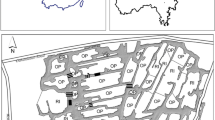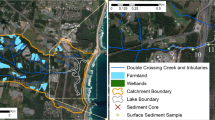Abstract
The Chickahominy River drains 790 km2 in southeastern Virginia, including approximately 155 km2 of dense commercial, industrial, and urban development in the upper basin near Richmond, Virginia. Previous studies have shown that total stream concentrations of trace metals and nutrients increased during storms, suggesting resuspension of contaminated sediments and (or) stormwater influxes of pollutants. The possible role of wetlands in maintaining water quality is of concern because the river furnishes about 46 percent of the water supply for the City of Newport News. Particle sizes of sediments and their corresponding total concentrations of carbon, nitrogen, copper, nickel, lead, and zinc were determined to assess their distribution within wetlands adjacent to the river. Except for Zn, concentrations of all measured constituents in the <63-μm-particle fraction were lower downstream of Richmond, suggesting that most contaminants are retained in the upper basin. Zinc concentrations increased along downstream reaches, peaking at 510 mg kg−1 approximately 8 km below the confluence of Upham Brook with the Chickahominy River. Lead concentrations up to 192 mg kg−1 were measured in sediments along Upham Brook near Richmond. Concentrations of Zn and Cu were highest in streambed sediments and lowest in elevated forested wetlands. The results suggest that the developing regions of the basin have a significant effect on sediment chemistry within the basin and that wetlands play a role in retaining these sediment-borne contaminants in upper reaches of the basin. Studies are underway to asses the stablity, of these sediments and the capacity of these contaminated wetlands to continue to assimilate them.
Similar content being viewed by others
Literature Cited
M. Bettinelli, U. Baroni, and N. Pastorelli. 1989. Microwave oven sample dissolution for the analysis of environmental and biological materials. Analytica Chimica Acta 225:159–174.
Cooper, J.R., J.W. Gilliam, R.B. Daniels, and W.P. Robarge. 1987. Riparian areas as filters for agricultural sediment. Soil Science Society of America Journal 51:416–420.
Correll, D.L. 1986. Watershed Research Perspectives. Smithsonian Institution Press, Washington, DC, USA.
Cowardin, L. M., V. Carter, F. C. Golet, and E. T. LaRoe. 1979. Classification of Wetlands and Deepwater Habitats of the United States, U.S. Fish and Wildlife Service, Washington, DC, USA. FWS/OBS-79/31.
Boto, K.G. and W.H. Patrick. 1979. Role of wetlands in the removal of suspended sediments. p. 479–489.In P.E. Greeson, J.R. Clark, and J.E. Clark (eds.) Wetland Functions and Values: The State of Our Understanding. American Water Resources Association, Minneapolis, MN, USA.
Gehrels, J. and G. Mulamootil. 1990. Hydrologic processes in a southern Ontario wetland. Hydrolbiologia 208:221–234.
Holland, M.M., D.F. Whigham, and B. Gopal. 1990. The characteristics of wetland ecotones. p. 171–197.In The Ecology and Management of Aquatic-Terrestrial Ecotones. The Parthenon Publishing Group, Paris, France.
Horowitz, A.J. 1991. A Primer on Sediment-trace Element Chemistry. Lewis Publishers, Chelsea, MI, USA.
Horowitz, A.J., K.A. Elrick. 1985. Multielement analysis of rocks and sediments by wet digestion and atomic absorption spectroscopy, U.S. Geological Survey, Reston, VA, USA, Open-File Report 85-78.
Horowitz, A.J., K.A. Elrick, C.R. Demas, and D.K. Demcheck. 1991. The use of sediment-trace element geochemical models for the identification of local fluvial baseline concentrations. p. 339–348.In N.E. Peters and D.E. Walling (eds.) Sediment and Stream Water Quality in a Changing Environment: Trends and Explanation. IAHS Publication No. 203.
Hupp, C.R., M.D. Woodside, and T.M. Yanosky. 1993. Sediment and trace element trapping in a forested wetland, Chickahominy River, Virginia. Wetlands 13:(in press).
Johnston, C.A., G.D. Bubenzer, G.B. Lee, W.F. Madison, and J.R. McHenry. 1984. Nutrient trapping by sediment deposition in a seasonally flooded lakeside wetland. Journal of Environmental Quality 13:283–290.
Johnston, C.A., N.E. Detenbeck, and G.J. Niemi. 1990. The cumulative effect of wetlands on stream water quality and quantity: a landscape approach. Biogeochemistry 10:105–141.
Kadlec, R.H. and J.A. Kadlec. 1979. Wetlands and water quality. p. 436–456.In P.E. Greeson, J.R. Clark, and J.E. Clark (eds.) Wetland Functions and Values: The State of Our Understanding. American Water Resources Association, Minneapolis, MN, USA.
Kleiss, B.A., E.E. Morris, J.F. Nix, and J.W. Barko. 1989. Modification of river water quality by an adjacent bottomland hardwood forest. Water Resources Bulletin 25:429–437.
LaBaugh, J. 1986. Wetland ecosystem studies from a hydrologic perspective, Water Resources Bulletin 22:1–10.
Lowrance, R., J.K. Sharpe, and J.M. Sheridan. 1986. Long-term sediment deposition in the riparian zone of a coastal plain watershed. Journal of Soil and Water Conservation 41:266–271.
Lowrance, R., R. Todd, J. Fail, O. Hendrickson, R. Leonard, and L. Asmusen. 1984. Riparian forests as nutrient filters in agricultural watersheds. Bioscience 34:374–377.
Nixon, S.W. and V. Lee. 1986. Wetlands and Water Quality. U.S. Army Corps of Engineers, Technical Report Y-86-2.
Phillips, J.D. 1989. Fluvial sediment storage in wetlands. Water Resources Bulletin 25:867–873.
Richardson, C.J. 1989. Freshwater wetlands: transformers, filters, or sinks? p. 25–46.In R.R. Sharitz and J.W. Gibbons (eds.) Freshwater Wetlands and Wildlife. U.S. Department of Energy, DOE Symposium Series No. 61, CONF-8603101.
Telang, S.A., R. Pocklington, A.S. Naidu, E.A. Romankevich, I.I. Gitelson, and M.I. Gladyshev. 1991. Carbon and mineral transport in major North American, Russian Arctic, and Siberian rivers: The ST Lawrence, the MacKenzie, The Yukon, the Arctic Alaskan rivers, the Arctic Basin rivers in the Soviet Union, and the Yenisei. p. 75–104.In E.T. Degens, S. Kempe, and J.E. Richey (eds.) Biogeochemistry of Major World Rivers. John Wiley and Sons, New York, NY, USA.
van der Valk, A.G., C.B. Davis, J.L. Baker, and C.E. Beer. 1979. Natural freshwater wetlands as nitrogen and phosphorus traps from land runoff. p. 457–467.In P.E. Greeson, J.R. Clark, and J.E. Clark (eds.) Wetland Functions and Values: The State of Our Understanding. American Water Resources Association, Minneapolis, MN, USA.
Author information
Authors and Affiliations
Rights and permissions
About this article
Cite this article
Puckett, L.J., Woodside, M.D., Libby, B. et al. Sinks for trace metals, nutrients, and sediments in wetlands of the Chickahominy River near Richmond, Virginia. Wetlands 13, 105–114 (1993). https://doi.org/10.1007/BF03160870
Received:
Revised:
Accepted:
Issue Date:
DOI: https://doi.org/10.1007/BF03160870




